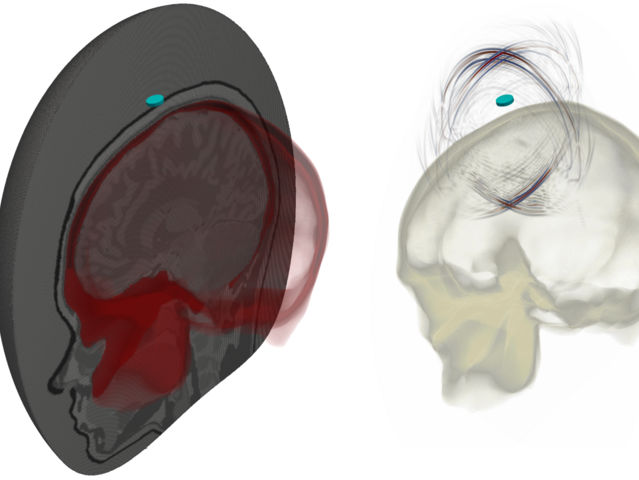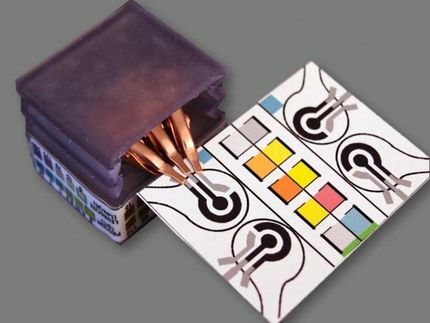New nanoscale technologies could revolutionize microscopes, study of disease
Research completed through a collaboration with University of Missouri engineers, biologists, and chemists could transform how scientists study molecules and cells at sub-microscopic (nanoscale) levels. Shubra Gangopadhyay, an electrical and computer engineer and her team at MU recently published studies outlining a new, relatively inexpensive imaging platform that enables single molecule imaging. This patented method highlights Gangopadhyay's more than 30 years of nanoscale research that has proven invaluable in biological research and battling diseases.

This diagram shows the difference between regular and plasmonic gratings in terms of fluorescent intensity.
Shubhra Gangopadhyay/Nanoscale
"Usually, scientists have to use very expensive microscopes to image at the sub-microscopic level," said Gangopadhyay, the C.W. LaPierre Endowed Chair of electrical and computer engineering in the MU College of Engineering. "The techniques we've established help to produce enhanced imaging results with ordinary microscopes. The relatively low production cost for the platform also means it could be used to detect a wide variety of diseases, particularly in developing countries."
The team's custom platform uses an interaction between light and the surface of the metal grating to generate surface plasmon resonance (SPR), a rapidly developing imaging technique that enables super-resolution imaging down to 65 nanometers--a resolution normally reserved for electron microscopes. Using HD-DVD and Blu-Ray discs as starting templates, a repeating grating pattern is transferred onto the microscope slides where the specimen will be placed. Since the patterns originate a widely used technology, the manufacturing process remains relatively inexpensive.
"In previous studies, we've used plasmonic gratings to detect cortisol and even tuberculosis," Gangopadhyay said. "Additionally, the relatively low production cost for the platform also means it could be used to further detect a wide variety of diseases, particularly in developing countries. Eventually, we might even be able to use smartphones to detect disease in the field."
Gangopadhyay's work also highlights the collaborations that are possible at the Mizzou. Working with the MU Departments of Bioengineering and Biochemistry, the team is helping to develop the next generation of undergraduate and graduate students. Patents and licenses developed by MU technologies help create and enhance relationships with industry, stimulate economic development, and impact the lives of state, national and international citizens.
"Plasmonic gratings with nano-protrusions made by glancing angle deposition (GLAD) for single-molecule super-resolution imaging" recently was published in Nanoscale, a journal of the Royal Society of Chemistry. The National Science Foundation provided partial funding for the studies. The content is solely the responsibility of the authors and does not necessarily represent the official views of the funding agency.
Original publication
Chen, B. and Wood, A. and Pathak, A. and Mathai, J. and Bok, S. and Zheng, H. and Hamm, S. and Basuray, S. and Grant, S. and Gangopadhyay, K. and Cornish, P. V. and Gangopadhyay, S.; "Plasmonic gratings with nano-protrusions made by glancing angle deposition for single-molecule super-resolution imaging"; Nanoscale; 2016
Most read news
Original publication
Chen, B. and Wood, A. and Pathak, A. and Mathai, J. and Bok, S. and Zheng, H. and Hamm, S. and Basuray, S. and Grant, S. and Gangopadhyay, K. and Cornish, P. V. and Gangopadhyay, S.; "Plasmonic gratings with nano-protrusions made by glancing angle deposition for single-molecule super-resolution imaging"; Nanoscale; 2016
Topics
Organizations
Other news from the department science

Get the analytics and lab tech industry in your inbox
By submitting this form you agree that LUMITOS AG will send you the newsletter(s) selected above by email. Your data will not be passed on to third parties. Your data will be stored and processed in accordance with our data protection regulations. LUMITOS may contact you by email for the purpose of advertising or market and opinion surveys. You can revoke your consent at any time without giving reasons to LUMITOS AG, Ernst-Augustin-Str. 2, 12489 Berlin, Germany or by e-mail at revoke@lumitos.com with effect for the future. In addition, each email contains a link to unsubscribe from the corresponding newsletter.
Most read news
More news from our other portals
Last viewed contents
Cornell: Project aims to sequence 2,500 genomes - Cornell plays key role in developing most detailed map of human DNA variation
New light shed on intensely studied material

Enzyme shown to regulate inflammation and metabolism in fat tissue
Protein Expression: Roche Diagnostics and Eppendorf Working Together

Imaging the brain with ultrasound waves
Adaltis receives favourable report for diagnostic test for HIV

Miniaturizable magnetic resonance

Scientists develop novel nanoparticles that could serve as contrast agents - Special feature: The properties of these unique nanoparticles change in reaction to heat

New mouse model makes stem cells light up green - Random find opens up new perspectives

Detailed structure of cell’s garbage disposal unit reveals surprise in how it is targeted by cancer drugs - Every atom counts

Tin-100, a doubly magic nucleus



















































